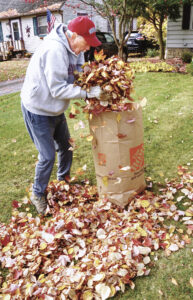Lecture puts focus on First Ladies
YOUNGSTOWN — Andrew Och’s PowerPoint presentation and question-and-answer session lasted 90 minutes, but the award-winning author and producer, known as “The First Ladies Man,” could have gone on for hours discussing “First Ladies in Wartime: An Interactive Lecture with Andrew Och” Monday afternoon at the Youngstown Historical Center of Industry and Labor.
Hosted by the Youngstown State University Department of Humanities through the Reeder Endowment in History, Och enthusiastically shared pre-White House stories and detailed insights about 10 first ladies while also discussing their leadership qualities and overall contributions to presidents and the United States.
He brought up the influence behind the scenes by Martha Washington, Abigail Adams, Dolley Madison, Mary Lincoln, Lucy Hayes, Edith Wilson, Lou Hoover, Eleanor Roosevelt, Mary “Mamie” Eisenhower and Laura Bush.
“Out of war and leading into war, these women have been unusual for their time to create this modern world whether directly, indirectly, subconsciously, just by falling in love with and / or marrying the man who beat all the odds out there and became president.
“They’re not elected. They’re not paid. There’s no legal obligation for them to fulfill this role, yet they do and they often shine. Whether we agree with that shine or not, they are trying to do the best that they can within those four to eight years to make the world a better place. And that’s what makes them unusual for their time.”
While focused on Adams and her relationship with second President John Adams, he could have been talking about any of the first ladies. “All of these women, whether they are on oil paintings or in the pages of history books, they are human beings. They live, they die, they breathe, they laugh, they cry, they win, they lose…”
Before talking about their guidance and impact while in the White House, Och detailed how some of these first ladies were wealthy or came from wealthy families prior to living at the world’s most famous address.
He described Martha Washington as “the first successful female CEO of the colonies.” Prior to marrying George, she inherited a large tobacco plantation after her first husband died.
Displaying a sense of forethought, Dolley Madison saved the official painting of Washington, the nation’s first president, as she escaped from the White House before British soldiers burned it down.
Born, raised and educated in Ohio, Och described Lucy Hayes as “transformative.” Among her acts, she visited Civil War encampments with her sewing machine and repaired soldiers’ uniforms.
“Lucy Hayes did it before it was cool to do it,” he said. “Lucy Hayes did it before it was a slogan or a bumper sticker — Pay It Forward.”
Wilson’s wife, Edith, was a trusted confidant in his decisions, including signing a declaration of war to enter World War I. After he suffered a stroke, she allowed very few people to see him during the rest of his presidency.
Och brought up his favorite first ladies in each century — Adams in the 1700s, Hayes in the 1800s, Hoover in the 1900s and Bush in the 2000s.
“Laura Bush is the last first lady that people love, for the most part, no matter what. Love her husband? You love Laura Bush. Didn’t vote for her husband? You say, ‘Too bad that wonderful lady is married to him.’ The difference is she’s the last first lady before social media blew up,” Och said.
Och’s interest in the subject may have started on Oct. 14, 1976, when a 7-year-old Och was encouraged by his mother to take a photo of and meet first lady Betty Ford. He showed that image on the screen as well as another photo of him posing next to the first lady’s car.
Recalling that he spoke in Youngstown 10 years ago, Och pointed out that since then, he wrote two books on first ladies (“Unusual for Their Time: On the Road with America’s First Ladies, Volumes 1 & 2”), gave nearly 350 speeches on them and worked as series producer for C-SPAN and the White House Historical Association series, “First Ladies: Influence and Image.” He is also among the board of directors for the National First Ladies Day Commission.
“I pinballed up, down, over and across the United States for a year and two months to gather every bit of information I could within a four-to-eight-hour period at every library, museum, school, church, home, birthplace, cemetery, train station, general store, attic, basement and safe.”
While the lecture focused on first ladies during wartime, Och’s deep knowledge of their roles in the White House was evident.
“They revealed themselves to me to be so important and so instrumental in so much more than we know or give credit to,” Och said. “In every location, I quickly found out that it is true — behind every great man is an even greater woman — or in this case, first lady.”

